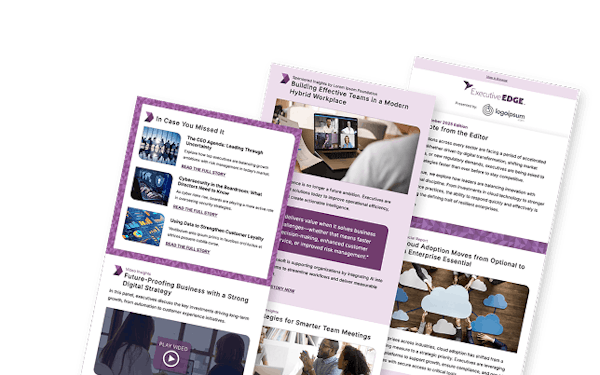Preparing for Volatility: Six Threats Risk Teams Must Tackle
Key Highlights
- Cyber threats now ripple into trade, supply and talent domains—treat them as enterprise-wide risks.
- Real-time signals of market shifts and supplier stress demand faster leadership response.
- Climate- and weather-driven losses are no longer peripheral—$100 billion insured loss in H1 2025 signals urgency.
- Talent and workforce misalignment is a hidden driver of financial loss—invest in skills and culture now.
Modern enterprises operate in a world where disruption is the new steady state. For board-level leaders, the interplay between cyber incidents, shifting trade alliances, climate shocks and workforce dynamics means that risks no longer sit neatly in separate silos. A resilience strategy rooted in integrated risk management, not simply mitigation, becomes a source of competitive advantage as much as protection. Executives must make risk-informed decisions around capital, operations and talent to safeguard profitability and position for the next cycle of growth.
This demands a mindset shift from “we have a cyber plan” or “we track supply-chain KPIs” toward “we understand how cyber, sourcing, weather and talent interact — and we coordinate across them.” Lowering cost is no longer enough; the new task is converting complexity into optionality, turning threats into strategic levers. The passage below from the article illustrates the depth of this shift.
As reported by Avery Larkin in “6 Risks that Should Be on Your Company’s Radar Screen in 2025” on Supply Chain Connect:
“Aon’s survey highlights the key forces shaping how companies operate, invest and plan for the future. Each one presents a potential threat, but also an opportunity for organizations that stay flexible and forward-looking. Here are six that all companies should be watching and responding to in 2025:
1. Cyber risk. Still the top concern globally, cyber threats continue to expand beyond IT departments. Rapid adoption of artificial intelligence (AI), automation and cloud platforms has multiplied exposure points. Aon warns that ‘the scale and complexity of attacks are increasing’ and pushing companies to integrate cyber resilience into both strategy and culture. ‘Organizations that integrate cyber awareness into their culture and strategic planning, use AI for both cyber defense and innovation, and implement comprehensive business continuity plans,’ it adds, ‘are better equipped to create value and sustain resilience.’
2. Market volatility. Trade tensions, conflicts and shifting alliances are reshaping global markets and making them more unpredictable. Aon says companies that can read market signals early and adjust quickly will be in the strongest position.
3. Supply chain disruption. Closely linked to geopolitical and climate risks, supply chain disruptions remain a costly and recurring problem for many organizations. Some viable solutions include more diversified sourcing efforts, building regional resilience and using data analytics to anticipate choke points before they happen.
4. Climate and weather risk. Climate change has moved from a long-term issue to a financial reality. In fact, Aon estimates insured losses from weather-related events hit $100 billion in the first half of 2025 alone. Integrating climate modeling into investment and location planning is now a core business need, it notes, and is no longer just a compliance exercise.
5. Economic and competitive pressures. As markets shift and costs rise, competition has jumped from number 10 to number five on Aon’s global ranking. Rising costs and tighter margins continue to test profitability, it says, and many organizations are rethinking pricing, sourcing and production strategies.
6. Workforce and talent challenges. Talent shortages and higher labor costs are impacting most industry sectors right now. And while this risk didn’t rank high on its list this year, Aon describes workforce risk as an ‘underrated driver of financial loss’ and says companies that invest in skills, data and culture alignment have the best chance of staying competitive. ‘Human resources (HR) leaders should be involved in all core areas of a company’s strategy so that workforce-related risks and emerging trends can be assessed and mitigated at an enterprise level,’ Aon advises.”
Continue reading “6 Risks that Should Be on Your Company’s Radar Screen in 2025” by Avery Larkin on Supply Chain Connect.
Why It Matters to You
For CEOs and senior executives, the significance of this article lies in the recognition that your risk exposures are broader and more interconnected than ever. Cyber incidents don’t stay in the IT inbox — they impact sourcing, production, shipments and workforce morale. Climate and supply shocks directly erode margins, just as talent gaps strain innovation. Strategy must now fold risk and resilience into growth and cost frameworks, not treat them as separate agendas.
Operationally, this means decision-makers must evaluate not just individual risks, but the intersections. For example, how a cyber disruption might cascade into supplier failure, or how a weather event could interplay with labor scarcity. By doing so, you can transform reactive risk budgeting into proactive operational levers, shifting from “how do we survive?” to “how do we thrive despite uncertainty?”
Next Steps
- CEO/Strategic Planning Lead: Conduct a cross-functional risk mapping workshop that overlays cyber, sourcing, workforce, climate and market risks. Identify three blind spots and assign owners.
- COO/Supply-Chain Lead: Initiate scenario modelling for each of the six risk domains — simulate a supply-chain outage, tariff shock, plus a workforce disruption — and define mitigation playbooks.
- CFO Finance: Quantify margin-impact scenarios for major risk events (e.g., weather loss of $100 M, cyber breach cost of $30 M) and build contingency buffers or insurance coverage accordingly.
- CHRO/Talent Lead: Elevate workforce resilience as strategic risk by launching a quarterly review of talent pipeline, skills gaps and labor-cost inflation linked to a risk dashboard.
- Chief Risk/CRO/CSO: Shift your annual risk-register refresh into an integrated “six-domain” register that you update quarterly, communicate to the board, and tie mitigation to KPIs (e.g., days to recovery, alternate-source ratio).
 Quiz
Quiz
Make smart decisions faster with ExecutiveEDGE’s weekly newsletter. It delivers leadership insights, economic trends, and forward-thinking strategies. Gain perspectives from today’s top business minds and stay informed on innovations shaping tomorrow’s business landscape.

